|
|
Convention on the Rights of Persons with Disabilities
New York, 13 December 2006
- Introductory Note
- Procedural History
- Documents
- Status
- Photo
By Michael Ashley Stein
Visiting Professor, Harvard Law School
Co-founder and Executive Director, Harvard Law School Project on Disability
By Janet E. Lord
Senior Fellow, Harvard Law School Project on Disability
Senior Legal Advisor, Special Rapporteur on the Rights of Persons with Disabilities
Adjunct Professor of International Law, University of Maryland Carey School of Law
I. Introduction
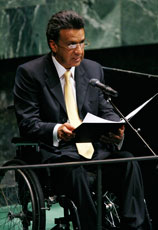 The Convention on the Rights of Persons with Disabilities (hereinafter “CRPD” or “Convention”) was adopted by consensus at the United Nations General Assembly on 13 December 2006, opened for signature on 30 March 2007, and attained the requisite number of ratifications for its entry into force on 3 May 2008. By 2023, it is nearing universal ratification, with 186 States Parties to the CRPD. There are 103 States Parties to the Optional Protocol to the CRPD (hereinafter “OP-CRPD”). The initiative to draft the first core international convention specifically addressing the human rights of persons with disabilities, came from a somewhat unlikely source. After several failed country-specific efforts to place disability on the international human rights law agenda, it was Mexico – a State with no particular track record of advancing disability rights in the international arena– that initiated the treaty process in 2001, following its successful effort to include disability as part of the Platform of Action adopted at the World Conference against Racism in Durban, South Africa. A few weeks thereafter, Mexico introduced a proposal at the meeting of the United Nations General Assembly in New York that resulted in the adoption of a resolution on 19 December 2001. The resolution called for the establishment of an Ad Hoc Committee to consider the elaboration of “a comprehensive and integral international convention to promote and protect the rights and dignity of persons with disabilities, based on the holistic approach in the work done in the field of social development, human rights and non-discrimination” (General Assembly resolution 56/168 of 19 December 2001). The Convention on the Rights of Persons with Disabilities (hereinafter “CRPD” or “Convention”) was adopted by consensus at the United Nations General Assembly on 13 December 2006, opened for signature on 30 March 2007, and attained the requisite number of ratifications for its entry into force on 3 May 2008. By 2023, it is nearing universal ratification, with 186 States Parties to the CRPD. There are 103 States Parties to the Optional Protocol to the CRPD (hereinafter “OP-CRPD”). The initiative to draft the first core international convention specifically addressing the human rights of persons with disabilities, came from a somewhat unlikely source. After several failed country-specific efforts to place disability on the international human rights law agenda, it was Mexico – a State with no particular track record of advancing disability rights in the international arena– that initiated the treaty process in 2001, following its successful effort to include disability as part of the Platform of Action adopted at the World Conference against Racism in Durban, South Africa. A few weeks thereafter, Mexico introduced a proposal at the meeting of the United Nations General Assembly in New York that resulted in the adoption of a resolution on 19 December 2001. The resolution called for the establishment of an Ad Hoc Committee to consider the elaboration of “a comprehensive and integral international convention to promote and protect the rights and dignity of persons with disabilities, based on the holistic approach in the work done in the field of social development, human rights and non-discrimination” (General Assembly resolution 56/168 of 19 December 2001).
The drafting process was characterized by other novelties. Notably, the CRPD was the first human rights treaty negotiation to benefit from the participation of its targeted stakeholders, including a diverse number of persons with disabilities, civil society, and representatives of national human rights institutions from all regions of the world. The Convention likewise was the first core human rights convention to be negotiated with access to the internet, Wi-Fi and smart phones during the drafting, facilitating communications between stakeholder participants at the United Nations and those not physically present. The negotiation was, therefore, both path-breaking and unusually transparent for a human rights treaty (Lord,2004).
II. Substantive Aspects
The CRPD, though distinctive in many respects from other core human rights conventions, bears the closest relationship to treaties that incorporate both civil and political as well as economic, social, and cultural rights (generations of human rights), and in particular, the Convention on the Rights of the Child (hereinafter “CRC”) (Stein,2007).
In the introductory articles of the CRPD, and novel for a human rights convention, the treaty’s purpose is outlined (art. 1) and definitions set forth (art. 2). Crucially, article 1 establishes disability as a social construct that arises from “interaction with various barriers may hinder their full and effective participation in society on an equal basis with others” rather than as an inherent limitation (art. 1). In doing so, the Convention presents disability as a natural and universal phenomenon of human diversity and rebuts the prevailing historical paradigms of disability as a medical deficit, focus of charity, or condition requiring a medical ‘cure’ or social welfare provision. Further, article 1 conceives of disability as being inclusive of and not limited to ‘long-term physical, mental, intellectual or sensory impairments’, which reflects a floor rather than a ceiling. Notably absent in article 2, the definitions article, is any definition of ‘disability’. Instead, in preambular paragraph (e), the treaty ‘[r]ecogniz[es] that disability is an evolving concept” that results from the interaction between persons with impairments and attitudinal and environmental barriers. Further, in preambular paragraph (p), the treaty recognizes that persons with disabilities, as with other groups experiencing disadvantage, have overlapping identities, the intersection of which can result in “multiple or aggravated forms of discrimination on the basis of race, colour, sex, language, religion, political or other opinion, national, ethnic, indigenous or social origin, property, birth, age or other status”.
The introductory articles are succeeded by seven articles of general application (arts. 3-9) that are relevant to the understanding, interpretation and implementation of all other articles in the Convention and are to be transversally applied. These include general guiding principles such as respect for individual dignity, autonomy, and independence (art. 3), obligations of States Parties with respect to domestic disability law, policy and programming (art. 4), awareness-raising measures to address some of the underlying determinants of disability discrimination (art. 8), and ensuring accessibility through dismantling of the physical, technological, information, communication, economic and social barriers that hinder the effective enjoyment of rights by persons with disabilities (art. 9).
A signal obligation that stands out among all core human rights conventions for its participatory directive is the requirement in article 4(3) that States consult with and involve persons with disabilities in developing and implementing legislation and policies and in decision-making processes concerning persons with disabilities. It reflects the often-quoted refrain of the disability community “Nothing about us without us”, and its placement in the general obligations provision gives it considerable heft as it must be applied transversally across the treaty. In this way, the CRPD elaborates more expansively than any other core human rights convention on the principle of participation and the right to be heard.
Further, the CRPD is the second convention, following the CRC, to specifically prohibit discrimination on the basis of disability (art. 5). It is the first to make explicit the definition of discrimination on the basis of disability (art. 2). As such, the CRPD’s disability discrimination framework is triggering an uptake of jurisprudence rooted in the Convention by treaty bodies beyond the CRPD Committee, human rights tribunals, and national level courts.
Articles 10-30 CRPD address the full spectrum of substantive obligations and how they are to be understood and applied so that persons with disabilities can fully enjoy their human rights. CRPD clarifies human rights law within the context of disability and contains standard articles on human rights and fundamental freedoms such as the right to life (art. 10), freedom from torture (art. 15), the right to education (art. 24), employment (art. 27), political participation (art. 29; elections and government, right to participate in), legal capacity (art. 12; right to be recognized as a person), access to justice (art. 13), freedom of expression and opinion (art. 21), privacy (art. 22; private and family life, right to respect for), participation in cultural life, sports and recreation (art. 30), respect for home and family (art. 23), personal integrity (art. 17), liberty of movement and nationality (art. 18), liberty and security of the person (art. 14) and an adequate standard of living (art. 28).
However, several articles bear no specific linkage to existing human rights norms as set out in prior conventions including articles on living independently (art. 19), personal mobility (art. 20), and habilitation and rehabilitation (art. 26). Further, one of the signal advances of the CRPD is its clear and unequivocal directive that children with disabilities be educated, and in inclusive settings using a “whole-of-institution” approach in identifying and mitigating barriers (de Beco, Quinlivan and Lord,2019). In these ways, the CRPD represents not only important developments in explicating human rights law in the context of disability rights, but also reflects important developments in international human rights law generally.
Implementation and monitoring measures are set forth in the ten subsequent articles, 31-40. The final provisions, articles 41-50, address rules governing the operation of the Convention, including, inter alia, its entry into force, amendments, and the official languages in which the Convention is available and considered equally authentic. Adopted at the same time as the CRPD, its Optional Protocol governs communications and procedures of inquiry, providing additional powers of review for the Convention’s treaty monitoring body, the CRPD Committee.
III. Procedural Aspects
The CRPD’s procedural and institutional mechanisms shore up its implementation and monitoring (Stein and Lord, 2010). First, it created the CRPD Committee, the body that monitors the implementation of the treaty through the familiar mechanism of State reporting and issues General Comments. The CRPD Committee is also authorized under the Optional Protocol to accept and deliberate upon individual and group complaints and communications (lodged directly by or on behalf of aggrieved individuals) regarding alleged violations of the treaty, but only those asserted against States Parties to the Optional Protocol (art. 1(2) OP-CRPD). The Optional Protocol to the CRPD also includes a procedure of inquiry, employed as in other human rights monitoring systems to allow the initiation of investigations, particularly regarding grave or systematic human rights violations (art. 6 OP-CRPD).
Second, article 40 establishes a regular Conference of States Parties (hereinafter “COSP”) that meets annually in New York at the United Nations Headquarters. The COSP has a mandate that goes beyond the typically more limited scope of operations in other human rights conventions and is tasked with considering “any matter with regard to the implementation of the [CRPD]” (art. 40(1)).
Finally, the CRPD establishes a national monitoring framework with several elements to facilitate implementation at the national level.
IV. The Practical Relevance and Impact of the CRPD
The practical relevance and impact of the CRPD are difficult to quantify; nonetheless, several indicators provide insight in this regard. The number of ratifications is now nearly universal at 186 for the CRPD yet lower but still significant at 103 for the Optional Protocol. Ninety-two States Parties have appeared before the CRPD’s treaty body. From 2010 to 2017, 71% of newly adopted national constitutions expressly incorporated disability as a prohibited ground of discrimination, 67% guaranteed the right to education for children with disabilities, and 58% guaranteed the right to work for adults with disabilities (WORLD Policy Analysis Center,2021). As of May 2018, 69% of low-income countries, 82% of middle-income countries, and 84% of high-income countries had legislative provisions explicitly prohibiting workplace discrimination based on disability (WORLD Policy Analysis Center, 2021). Further, as of May 2018, 34% of low-income countries, 48% of middle-income countries, and 67% of high-income countries had legislative provisions requiring the provision of reasonable workplace accommodations for persons with disabilities (WORLD Policy Analysis Center, 2021). The CRPD has likewise influenced regional systems of human rights protection as evidenced by the adoption in 2018 of the Protocol to the African Charter on Human and Peoples' Rights on the Rights of Persons with Disabilities in Africa.
Disability inclusive policies adopted by the major international development donors (bilateral and multilateral) are likewise proliferating, as are commitments to ensure that development projects are inclusive of persons with disabilities as participants in and beneficiaries of all development projects. Among these, the World Bank has committed to ensuring that its projects are disability inclusive across its portfolio by 2025.
The Sustainable Development Goals incorporate disability-inclusive elements and targets (General Assembly resolution 70/1 of 25 September 2015). Seven targets address persons with disabilities in specific terms with regard to education, accessible schools, employment, accessible public spaces and transport, empowerment and inclusion, and data disaggregation. Others refer to persons in vulnerable situations, address discrimination, or are universal in application and are therefore understood to include persons with disabilities.
The United Nations also adopted a Disability Inclusion Strategy (UNDIS) in 2019 to ensure that the United Nations system moves towards sustainable and transformative progress on disability inclusion through all pillars of its work, including a system-wide policy and an accountability framework.
Within the humanitarian sector, disability inclusion is now the subject of extensive guidelines adopted by the Inter-Agency Standing Committee, and was acknowledged by the Secretary-General during the 2016 World Humanitarian Summit ( Report of the Secretary-General for the World Humanitarian Summit (A/70/709,2 February 2016)). The inclusion of a provision on the protection of persons with disabilities in situations of risk, in article 11 of the CRPD, provided the much-needed impetus for refocusing humanitarian assistance in the direction of a rights-based, social model understanding of disability. More work is required to foment a dynamic treaty practice in relation to Article 11 in the specific context of protection in armed conflict to ensure that the international humanitarian law principles applicable to persons with disabilities are operationalized (Lord, 2022; Pons, Lord & Stein, 2022).
More difficult is the capturing of the treaty’s connectivity and motion locally, on the ground where specific CRPD advocacy has yielded concrete change:
- The parent in China who presented a copy of the CRPD to a school principal and managed to pry open the doors of a school to his child (and children of other parents) with a disability (Interview with Guernsey, 2020).
- The Zambian disabled peoples’ organization (DPO) which took up the case of a deaf teen falsely accused of killing his stepfather and demanded that the boy have access to legal counsel and the means to communicate effectively to aid his defence (Lord and Stein, Deaf Identity and Rights in Africa, 2015).
- The Paraguayan DPO which, invoking article 31 of the CRPD, succeeded in placing disability questions on its national census, thereby resulting in a more than threefold increase in the population of persons with disabilities (Eduardo Rodríguez-Frías, n.d.).
- The East African regional network of activists with Albinism who see in the CRPD an opportunity to press for access to quality sunscreen and to challenge stigma and mythology about albinism that is connected to ritual killings (“Report of the Independent Expert on the enjoyment of human rights by persons with albinism in Africa”,(A/HRC/37/57/Add.3, 19 December 2017)).
- The activists who successfully invoked the CRPD, first before the European Court of Human Rights and then the CRPD Committee, to uphold their right to vote despite their country barring everyone placed under guardianship from exercising the franchise (Lord, Stein and Fiala-Butora,2014).
|
The impact of CRPD is thus both easy and difficult to ascertain.
V. Conclusion
The CRPD is a major success story in the field of international human rights. This is attributable in part to the extremely marginal status of persons with disabilities in law, policy and practice worldwide prior to the adoption of the CRPD. The treaty was ratified quickly and broadly across the globe and has been the impetus for domestic disability law and policy reform and for an elevation of disability rights in international policy frameworks and practices. It was a long time in coming and far more work is needed to bring its provisions into the folds of domestic and international practices to the benefit of some one billion persons across the globe.
This Introductory Note was written in February 2023.
Related Materials
A. Legal Instruments
Convention on the Rights of Persons with Disabilities, New York, 13 December 2006, United Nations, Treaty Series, vol. 2515, p. 3.
Optional Protocol to the Convention on the Rights of Persons with Disabilities, New York, 13 December 2006, United Nations, Treaty Series, vol. 2518, p. 283.
Protocol to the African Charter on Human and Peoples' Rights on the Rights of Persons with Disabilities in Africa, Addis Ababa, 29 January 2018, African Union.
B. Documents
United Nations World Conference on Human Rights, Vienna Declaration and Programme of Action: Note by the secretariat, A/CONF.157/23, 12 July 1993.
United Nations World Conference on Human Rights, Report of the World Conference on Human Rights: Report of the Secretary-General, A/Conf.157/24, 13 October 1993.
General Assembly resolution 48/96 of 20 December 1993 (Standard Rules for the Equalization of Opportunities for Persons with Disabilities).
Committee on Economic, Social and Cultural Rights, General Comment No. 3 (2001) on the Compilation of General Comments and General Recommendations Adopted by Human Rights Treaty Bodies, HRI/GEN/1/Rev.5, 26 April 2001.
General Assembly resolution 56/168 of 26 February 2002 (Comprehensive and integral international convention to promote and protect the rights and dignity of persons with disabilities).
United Nations Ad Hoc Committee on a Comprehensive and Integral International Convention on the Protection and Promotion of the Rights and Dignity of Persons with Disabilities, Report of the Working Group to the Ad Hoc Committee, A/AC.265/2004/WG/1, 27 January 2004.
United Nations, Report of the World Conference on Disaster Reduction, Chapter I, Hyogo Framework for Action 2005–2015: Building the Resilience of Nations and Communities to Disasters, A/CONF.206/6, 16 March 2005.
General Assembly, The right to education of persons with disabilities: Report of the Special Rapporteur on the Right to Education, A/HRC/4/29, 19 February 2007.
Human Rights Council, Thematic Study by the Office of the United Nations High Commissioner for Human Rights on enhancing awareness and understanding of the Convention on the Rights of Persons with Disabilities, A/HRC/10/48, 26 January 2009.
World Health Organization, World Report on Disability, 2011.
Committee on the Rights of Persons with Disabilities, General Comment No. 2 (2014), Article 9, Accessibility, CRPD/C/GC/2, 22 May 2014.
General Assembly resolution 69/283 of 23 June 2015 (Sendai Framework for Disaster Risk Reduction 2015-2030).
General Assembly resolution 70/1 of 21 October 2015 (Transforming Our World: The 2030 Agenda for Sustainable Development).
General Assembly resolution 70/90 of 2 February 2016 (One Humanity: Shared Responsibility, Report of the Security-General for the World Humanitarian Summit).
The World Bank, World Bank Environmental and Social Framework, 2016.
General Assembly, Report of the Independent Expert on the Enjoyment of Human Rights by Persons with Albinism on the Regional Action Plan on Albinism in Africa (2017-2021), A/HRC/37/57/Add.3, 19 December 2017.
Committee on the Rights of Persons with Disabilities, General Comment No. 6 (2018) on Equality and Non-Discrimination, CRPD/C/GC/6, 26 April 2018.
United Nations, United Nations Disability Inclusion Strategy, 2019.
C. Doctrine
I. Bantekas, M. A. Stein, and D. Anastasiou (eds.), The UN Convention on the Rights of Persons With Disabilities: A Commentary, Oxford University Press, Oxford, 2008.
G. de Beco (ed), Article 33 of the UN Convention on the Rights of Persons with Disabilities: National Structures for the Implementation and Monitoring of the Convention, Martinus Nijhoff, Leiden, Boston, 2013.
G. de Beco, S. Quinlivan, and J. E. Lord (eds.), The Right to Inclusive Education in International Human Rights Law, Cambridge University Press, Cambridge, 2019.
P. Harpur and M. A. Stein, “Children with Disabilities, Human Rights and Sustainable Development” in C. Fenton-Glynn (ed), Children’s Rights and Sustainable Development: Interpreting the UNCRC for Future Generations, Cambridge University Press, Cambridge, 2019 .
R. Kayess and P. French, “Out of Darkness into Light? Introducing the Convention on the Rights of Persons with Disabilities”, Human Rights Law Review, vol. 8, Issue 1, 2008, pp. 1–34.
J.E. Lord, “Accounting for Disability in International Humanitarian Law”, International Review of the Red Cross, Vol. 105, Issue 922, 2022, pp. 60-98.
J. E. Lord, “Mirror, Mirror on the Wall: Voice Accountability and NGOs in Human Rights Standard Setting”, Seton Hall Journal of Diplomacy and International Relations, Vol. 5, Issue 2, 2004, pp. 93-110.
J. E. Lord and M. A. Stein, “Deaf Identity and Rights in Africa: Advancing Equality through the Convention on the Rights of Persons with Disabilities” in A. C. Cooper and K. K. Rashid (eds), Citizenship, Politics, Difference: Perspectives from Sub-Saharan Signed Language Communities, Gallaudet University Press, Washington D.C., 2015.
J. E. Lord and M. A. Stein, “Participatory Justice, the UN Disability Human Rights Convention, and the Right to Participate in Sport, Recreation, and Play” in J. Kumpuvuori and M. Scheinin (eds), The United Nations Convention on the Rights of Persons with Disabilities: Multidisciplinary Perspectives, Center for Human Rights of Persons with Disabilities in Finland (VIKE), Helsinki, 2010.
J. E. Lord and M. A. Stein, “The Domestic Incorporation of Human Rights Law and the United Nations Convention on the Rights of Persons with Disabilities”, Washington Law Review, vol. 83, 2008, pp. 449-479.
J. E. Lord, M. A. Stein, and J. Fiala-Butora, “Facilitating an Equal Right to Vote for Persons with Disabilities”, Journal of Human Rights Practice, Vol. 6, Issue 1, 2014, pp. 115-139.
D. Mont and M. Loeb, “A Functional Approach to Assessing the Impact of Health Interventions on People with Disabilities”, Alter, vol. 4, Issue 3, 2010, pp. 159-173.
W.I. Pons, J.E. Lord, J., & M.A. Stein, “Addressing the accountability void: War crimes against persons with disabilities”, International Review of the Red Cross, Vol. 105, Issue 922, pp. 465-483.
W.I. Pons, J.E. Lord, & M.A. Stein, “Disability, Human Rights Violations, and Crimes Against Humanity”, 116(1) American Journal of International Law, Vo. 116, Issue 1, 2022, pp. 58-95.
H. Quinn, “Disability and Human Rights: A New Field in the United Nations” in C. Krause and M. Scheinin (eds), International Protection of Human Rights: A Textbook, Abo Akademi University Institute for Human Rights, Turku, 2009.
D. Schiek, L. B. Waddington, and M. Bell, Cases, Materials and Text on National, Supranational and International Non-Discrimination Law, Hart, Oxford, 2007.
O. de Schutter, “Reasonable Accommodations and Positive Obligations in the European Convention on Human Rights” in A. Lawson and C. Gooding (eds), Disability Rights in Europe: From Theory to Practice, Hart, Oxford, 2005.
A. Silvers, M.A. Stein, “Disability, Equal Protection, and the Supreme Court: Standing at the Crossroads of Progressive and Retrogressive Logic in Constitutional Classification”, University of Michigan Journal of Law Reform, vol. 35, Issue 1, 2001.
M. A. Stein, “Disability Human Rights”, California Law Review, vol. 95, 2007, pp. 75-121.
M. A. Stein and J. E. Lord, “Monitoring the Committee on the Rights of Persons with Disabilities: Innovations, Lost Opportunities, and Future Potential”, Human Rights Quarterly, vol. 32, no. 3, 2010, pp. 689-728.
M. A. Stein and J. E. Lord, “The United Nations Convention on the Rights of Persons with Disabilities: Process, Substance, and Prospects” in F. G. Isa and K. de Feyter (eds), International Hunan Rights Law in a Global Context, University of Deusto, Bilbo, Bizkaia, 2008.
M. A. Stein and P. J. S. Stein, “Disability, Development, and Human Rights: A Mandate and Framework for International Financial Institutions”, University of California Davis Law Review, vol. 47, 2014, pp. 1231-1278.
M. A. Travis, “Perceived Disabilities, Social Cognition, and ‘Innocent Mistakes’”, Vanderbilt Law Review, vol. 55, 2002, pp. 481-579.
D. Additional Documents
Mental Disability Rights International, Human Rights & Mental Health: Mexico (report), 2000.
E. Rodríguez-Frías, Disabilities and Inclusion in Paraguay, Inter-American Foundation, 2014.
C. V. Mcclain-Nhlapo, D. S. Raja, L. H. A. Sivonen, E. O. Tas, and D. Widyastuty, Including persons with disabilities in water sector operations: a guidance note (English), World Bank Group, 2017.
Inter-Agency Standing Committee, website: https://interagencystandingcommittee.org/
World Policy Analysis Center: Disability, website: https://www.worldpolicycenter.org/topics/disability/policies
The issue of the rights of persons with disabilities had been on the agenda of various organs of the United Nations for many years before steps were taken to draft a binding instrument.
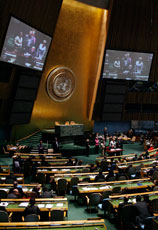 An early effort to codify the rights of persons with specific disabilities led the General Assembly to adopt a Declaration on the Rights of Mentally Retarded Persons by resolution 2856 (XVI) of 20 December 1971. Four years later, the Declaration on the Rights of Disabled Persons followed, which provided a definition for the term “disabled person” and formulated a corresponding set of rights (General Assembly resolution 3447 (XXX) of 9 December 1975). The General Assembly, by adoption of resolution 31/82 of 13 December 1976, entitled “Implementation of the Declaration on the Rights of Disabled Persons”, recommended, inter alia, that all Member States should take account of the rights and principles laid down in the Declaration in establishing their policies, plans and programmes. During the same session, the General Assembly proclaimed 1981 the “International Year for Disabled Persons”, with the theme “full participation” (General Assembly resolution 31/123 of 16 December 1976; by resolution 34/154 of 17 December 1979, the General Assembly expanded the theme to “full participation and equality” and changed the name to the “International Year of Disabled Persons”). An early effort to codify the rights of persons with specific disabilities led the General Assembly to adopt a Declaration on the Rights of Mentally Retarded Persons by resolution 2856 (XVI) of 20 December 1971. Four years later, the Declaration on the Rights of Disabled Persons followed, which provided a definition for the term “disabled person” and formulated a corresponding set of rights (General Assembly resolution 3447 (XXX) of 9 December 1975). The General Assembly, by adoption of resolution 31/82 of 13 December 1976, entitled “Implementation of the Declaration on the Rights of Disabled Persons”, recommended, inter alia, that all Member States should take account of the rights and principles laid down in the Declaration in establishing their policies, plans and programmes. During the same session, the General Assembly proclaimed 1981 the “International Year for Disabled Persons”, with the theme “full participation” (General Assembly resolution 31/123 of 16 December 1976; by resolution 34/154 of 17 December 1979, the General Assembly expanded the theme to “full participation and equality” and changed the name to the “International Year of Disabled Persons”).
By resolution 32/133 of 16 December 1977, the General Assembly established an Advisory Committee for the Year of Disabled Persons. On the basis of the work of the Advisory Committee, the General Assembly adopted the World Programme of Action concerning Disabled Persons by resolution 37/52 of 3 December 1982. On the same day, the General Assembly proclaimed the period 1983-1992 United Nations Decade of Disabled Persons (resolution 37/53 of 3 December 1982). Ten years later, the General Assembly would proclaim 3 December as the International Day of Disabled Persons (resolution 47/3 of 14 October 1992).
With the conclusion of the United Nations Decade of Disabled Persons approaching, the Economic and Social Council, on 24 May 1990, authorized the Commission of Social Development to consider the establishment of an ad hoc open-ended working group of government experts to elaborate standard rules on the equalization of opportunities for disabled children, youth and adults (Economic and Social Council resolution 1990/26). The resulting Standard Rules on Equalization of Opportunities for Persons with Disabilities was adopted by the General Assembly on 20 December 1993 (resolution 48/96).
While recalling the Standard Rules, the Commission on Human Rights, on 25 April 2000, invited the United Nations High Commissioner for Human Rights to examine measures to strengthen the protection and monitoring of human rights of persons with disabilities by its resolution 2000/51.
The World Conference against Racism, Racial Discrimination, Xenophobia and Related Intolerance, held in Durban, South Africa, from 31 August to 8 September 2001, recommended that the General Assembly consider elaborating an integral and comprehensive international convention to protect and promote the rights and dignity of disabled persons, including, especially, provisions that would address the discriminatory practices and treatment affecting them (A/CONF.189/12, Chap I, para 180).
Uniting all these strands, on 19 December 2001, under agenda item 119 (b), entitled “Human rights questions, including alternative approaches for improving the effective enjoyment of human rights and fundamental freedoms”, the General Assembly established an Ad Hoc Committee to consider proposals for a comprehensive and integral international convention on the protection and promotion of the rights and dignity of persons with disabilities, based on the holistic approach of the work done in the fields of social development, human rights and non-discrimination, and taking into account the recommendations of the Commission on Human Rights and the Commission for Social Development, and the recommendation of the World Conference against Racism, Racial Discrimination, Xenophobia and Related Intolerance (resolution 56/168). The General Assembly renewed the mandate of the Ad Hoc Committee on a Comprehensive and Integral International Convention on the Protection and Promotion of the Rights and Dignity of Persons with Disabilities four times from 2002 to 2005 (resolutions 57/229 of 18 December 2002, 58/246 of 23 December 2003, 59/198 of 20 December 2004, and 60/232 of 23 December 2005).
During its first session, held from 29 July to 9 August 2002, the Ad Hoc Committee set out procedures for the participation of representatives from non-governmental organizations and recommended a draft resolution to the General Assembly (A/57/357). At its second session, held from 16 to 27 June 2003, the Ad Hoc Committee decided to establish a working group with the aim of preparing and presenting a draft text, which would be the basis for negotiation by Member States and observers (A/58/118 and Corr.1).
The Working Group of the Ad Hoc Committee, which consisted of twenty-seven governmental representatives designated by regional groups, twelve representatives from non-governmental organizations and one representative of national human rights institutions, met from 5 to 16 January 2004. It produced a draft comprehensive and integral international convention on the protection and promotion of the rights and dignity of persons with disabilities, which it annexed to its report to the Ad Hoc Committee (A/AC.265/2004/WG/1).
At its third session, held from 24 May to 4 June 2004, the Ad Hoc Committee began negotiating a draft convention, on the basis of the draft text prepared by the Working Group, and commenced a first reading of the draft text (A/AC.265/2004/5, Corr.1 and Corr.2). At its fourth session, which was held from 23 August to 3 September 2004, the Ad Hoc Committee completed the first reading of the draft text and conducted a review of specific draft articles (Report of the fourth session of the Ad Hoc Committee on a Comprehensive and Integral International Convention on the Protection and Promotion of the Rights and Dignity of Persons with Disabilities, A/59/360). During its fifth session, which took place from 24 January to 4 February 2005, the Ad Hoc Committee continued its informal discussions on specific draft articles and proposed additional articles (Report of the fifth session of the Ad Hoc Committee on a Comprehensive and Integral International Convention on the Protection and Promotion of the Rights and Dignity of Persons with Disabilities, A/AC.265/2005/2). The Ad Hoc Committee continued its informal discussions during its sixth and seventh sessions, from 1 to 12 August 2005 and from 16 January to 3 February 2006, respectively (Report of the sixth and seventh sessions of the Ad Hoc Committee on a Comprehensive and Integral International Convention on the Protection and Promotion of the Rights and Dignity of Persons with Disabilities, respectively A/60/266 and A/AC.265/2006/2). At its eighth session, held from 14 to 25 August 2006, the Ad Hoc Committee concluded its negotiations and adopted the draft text of a convention on the rights of persons with disabilities, including an optional protocol, without a vote. It also decided to establish an open-ended drafting group to conduct a technical review of the draft (Report of the eighth session of the Ad Hoc Committee on a Comprehensive and Integral International Convention on the Protection and Promotion of the Rights and Dignity of Persons with Disabilities A/AC.265/2006/4 and Add.1). At its resumed eighth session, on 5 December 2006, the Ad Hoc Committee decided to recommend to the General Assembly for adoption a draft resolution entitled “Convention on the Rights of Persons with Disabilities”, to which it annexed the draft Convention and draft Optional Protocol (Final Report of the eighth session of the Ad Hoc Committee on a Comprehensive and Integral International Convention on the Protection and Promotion of the Rights and Dignity of Persons with Disabilities, A/61/611).
On 13 December 2006, the General Assembly adopted by consensus, without reference to a Main Committee, the Convention on the Rights of Persons with Disabilities and its Optional Protocol, as annexed to resolution 61/106. In accordance with its article 45, paragraph (1), the Convention entered into force on 3 May 2008, on the thirtieth day after the date of the deposit of its twentieth instrument of ratification or accession.
The Convention established a Committee on the Rights of Persons with Disabilities, whose first twelve members were elected during the first Conference of the States Parties on 3 November 2008, in accordance with article 34 of the Convention (CRPD/CSP/2008/4). Pursuant to article 34, paragraph (2) of the Convention, the Conference of the States Parties increased the membership of the Committee by six members on 1 September 2010 (CRPD/CSP/2010/3). The Committee held its first session from 23 to 27 February 2009, and continues to meet twice a year at the United Nations Office in Geneva.
Text of the Convention
Selected preparatory documents
(in chronological order)
General Assembly resolution 2856 (XXVI) of 20 December 1971 (Declaration on the Rights of Mentally Retarded Persons)
General Assembly resolution 3447 (XXX) of 9 December 1975 (Declaration on the Rights of Disabled Persons)
General Assembly resolution 31/82 of 13 December 1976 (Implementation of the Declaration on the Rights of Disabled Persons)
General Assembly resolution 31/123 of 16 December 1976 (International Year for Disabled Persons)
General Assembly resolution 32/133 of 16 December 1977 (International Year of Disabled Persons)
Report of the Advisory Committee for the Year of Disabled Persons, 5 to 14 July 1982 (A/37/352/Add.1)
General Assembly resolution 34/154 of 17 December 1979 (International Year of Disabled Persons)
General Assembly resolution 37/52 of 3 December 1982 (World Programme of Action concerning Disabled Persons)
General Assembly resolution 37/53 of 3 December 1982 (Implementation of the World Programme of Action concerning Disabled Persons)
Economic and Social Council resolution 1990/26 of 24 May 1990 (Equalization of opportunities for disabled persons)
General Assembly, Verbatim record of plenary meetings Nos. 33 to 36 of the forty-seventh regular session, held from 12 to 13 October 1992 (A/47/PV.33, A/47/PV.34, A/47/PV.35, A/47/PV.36)
General Assembly resolution 47/3 of 14 October 1992 (International Day of Disabled Persons)
Third Committee of the General Assembly, Summary records of meetings No. 18 of the forty-eighth regular session held 28 October 1993 (A/C.3/48/SR.18)
General Assembly resolution 48/96 of 20 December 1993 (Standard rules on equalization of opportunities for persons with disabilities)
Commission of Human Rights resolution 2000/51 of 25 April 2000 (Human rights of persons with disabilities)
Report of the World Conference against Racism, Racial discrimination, Xenophobia and Related Intolerance (31 August to 8 September 2001, Durban, South Africa) (A/CONF.189/12)
Third Committee of the General Assembly, Summary records of meeting No. 55 of the fifty-sixth regular session, of 30 November 2001 (A/C.3/56/SR.55)
General Assembly resolution 56/168 of 19 December 2001 (Comprehensive and integral international convention to promote and protect the rights and dignity of persons with disabilities)
Report of the first session of the Ad Hoc Committee on a Comprehensive and Integral International Convention on the Protection and Promotion of the Rights and Dignity of Persons with Disabilities, 29 July to 9 August 2002 (A/57/357)
General Assembly resolution 57/229 of 18 December 2002 (Comprehensive and integral international convention to promote and protect the rights and dignity of persons with disabilities)
Report of the second session of the Ad Hoc Committee on a Comprehensive and Integral International Convention on the Protection and Promotion of the Rights and Dignity of Persons with Disabilities, 16 to 27 June 2003 (A/58/118 and Corr.1)
General Assembly resolution 58/246 of 23 December 2003 (Ad Hoc Committee on a Comprehensive and Integral International Convention on the Protection and Promotion of the Rights and Dignity of Persons with Disabilities)
Report of the Working Group to the Ad Hoc Committee on a Comprehensive and Integral International Convention on the Protection and Promotion of the Rights and Dignity of Persons with Disabilities, 5 to 16 January 2004 (A/AC.265/2004/WG/1)
Report of the third session of the Ad Hoc Committee on a Comprehensive and Integral International Convention on the Protection and Promotion of the Rights and Dignity of Persons with Disabilities, 24 May to 4 June 2004 (A/AC.265/2004/5, Corr.1 and Corr.2)
Report of the fourth session of the Ad Hoc Committee on a Comprehensive and Integral International Convention on the Protection and Promotion of the Rights and Dignity of Persons with Disabilities, 23 August – 3 September 2004 (A/59/360)
General Assembly resolution 59/198 of 22 December 2004 (Ad Hoc Committee on a Comprehensive and Integral International Convention on the Protection and Promotion of the Rights and Dignity of Persons with Disabilities)
Report of the Third Committee to the General Assembly (A/59/503/Add.2, 9 December 2004)
Report of the fifth session of the Ad Hoc Committee on a Comprehensive and Integral International Convention on the Protection and Promotion of the Rights and Dignity of Persons with Disabilities, 24 January to 4 February 2005 (A/AC.265/2005/2)
Report of the sixth session of the Ad Hoc Committee on a Comprehensive and Integral International Convention on the Protection and Promotion of the Rights and Dignity of Persons with Disabilities, 1 to 12 August 2005 (A/60/266)
General Assembly resolution 60/232 of 23 December 2005 (Ad Hoc Committee on a Comprehensive and Integral International Convention on the Protection and Promotion of the Rights and Dignity of Persons with Disabilities)
Report of the seventh session of the Ad Hoc Committee on a Comprehensive and Integral International Convention on the Protection and Promotion of the Rights and Dignity of Persons with Disabilities, 16 January to 3 February 2006 (A/AC.265/2006/2)
Interim Report of the eighth session of the Ad Hoc Committee on a Comprehensive and Integral International Convention on the Protection and Promotion of the Rights and Dignity of Persons with Disabilities, 14 to 25 August 2006 (A/AC.265/2006/4 and Add.1)
Final Report of the eighth session of the Ad Hoc Committee on a Comprehensive and Integral International Convention on the Protection and Promotion of the Rights and Dignity of Persons with Disabilities, 14 to 25 August and 5 December 2006 (A/61/611).
Documents of all the eight sessions of the Ad Hoc Committee on a Comprehensive and Integral International Convention on the Protection and Promotion of the Rights and Dignity of Persons with Disabilities can be found at http://www.un.org/esa/socdev/enable/rights/adhoccom.htm
General Assembly, Verbatim record of the 76th plenary meeting of the sixty-first regular session, held on 13 December 2006 (A/61/PV.76)
General Assembly resolution 61/106 of 13 December 2006 (Convention on the Rights of Persons with Disabilities)
Report of the Conference of State Parties to the Convention on the Rights of Persons with Disabilities, 31 October to 3 November 2008 (CRPD/CSP/2008/4)
Report of the third session of the Conference of States Parties to the Convention on the Rights of Persons with Disabilities, 1 to 3 September 2010 (CRPD/CSP/2010/3)
Text of the Convention on the Rights of Persons with Disabilities
Optional Protocol to the Convention on the Rights of Persons with Disabilities
The Convention entered into force on 3 May 2008. For the current participation status of the Convention, as well as information and relevant texts of related treaty actions, such as reservations, declarations, objections, denunciations and notifications, see:
The Status of Multilateral Treaties Deposited with the Secretary-General
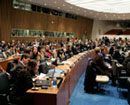 |
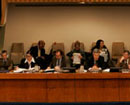 |
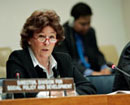 |
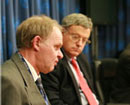 |
16 January 2006
Conference Room 4, United Nations Headquarters, New York.
[Read more]
|
18 January 2006
Conference Room 4, United Nations Headquarters, New York.
[Read more] |
27 January 2006
Conference Room 4, United Nations Headquarters, New York.
[Read more] |
3 February 2006
Press conference, United Nations Headquarters, New York.
[Read more] |
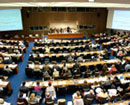 |
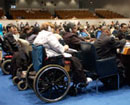 |
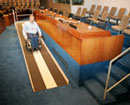 |
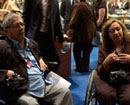 |
14 August 2006
Conference Room 4, United Nations Headquarters, New York.
[Read more]
|
14 August 2006
Conference Room 4, United Nations Headquarters, New York.
[Read more] |
11 August 2006
Conference Room 4, United Nations Headquarters, New York.
[Read more] |
18 August 2006
Conference Room 4, United Nations Headquarters, New York.
[Read more] |
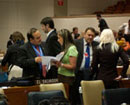 |
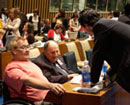 |
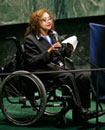 |
 |
18 August 2006
Conference Room 4, United Nations Headquarters, New York.
[Read more] |
18 August 2006
Conference Room 4, United Nations Headquarters, New York.
[Read more] |
13 December 2006
61st Session of the General Assembly, 76th Plenary Meeting, United Nations Headquarters, New York.
[Read more]
|
29 March 2006
Press conference, United Nations Headquarters, New York.
[Read more] |
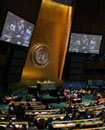 |
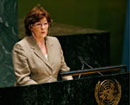 |
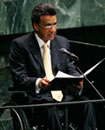 |
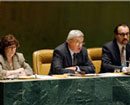 |
30 March 2007
Signing Ceremony, General Assembly Hall, United Nations Headquarters, New York.
[Read more]
|
30 March 2007
Signing Ceremony, General Assembly Hall, United Nations Headquarters, New York.
[Read more] |
30 March 2007
Signing Ceremony, General Assembly Hall, United Nations Headquarters, New York.
[Read more] |
30 March 2007
Signing Ceremony, General Assembly Hall, United Nations Headquarters, New York.
[Read more] |
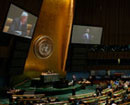 |
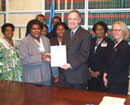 |
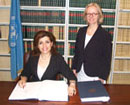 |
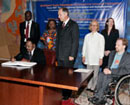 |
30 March 2007
Signing Ceremony, General Assembly Hall, United Nations Headquarters, New York.
[Read more] |
17 May 2007
Signing of the Convention on the Rights of Persons with Disabilities, United Nations Headquarters, New York.
[Read more]
|
14 June 2007
Signing of the Convention on the Rights of Persons with Disabilities, United Nations Headquarters, New York.
[Read more] |
25 September 2007
Signing of the Convention on the Rights of Persons with Disabilities, United Nations Headquarters, New York.
[Read more] |
 |
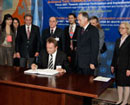 |
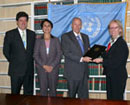 |
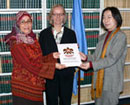 |
26 September 2007
Signing of the Convention on the Rights of Persons with Disabilities,
United Nations Headquarters, New York.
[Read more]
|
27 September 2007
Signing of the Convention on the Rights of Persons with Disabilities, United Nations Headquarters, New York.
[Read more] |
17 December 2007
Ratification of the Convention on the Rights of Persons with Disabilities,
United Nations Headquarters, New York.
[Read more] |
8 February 2008
Signing of the Convention on the Rights of Persons with Disabilities, United Nations Headquarters, New York.
[Read more] |
 |
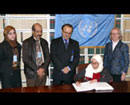 |
|
|
8 February 2008
Signing of the Convention on the Rights of Persons with Disabilities,
United Nations Headquarters, New York.
[Read more] |
12 February 2008
Signing of the Optional Protocol to the Convention on the Rights of Persons with Disabilities, United Nations Headquarters, New York.
[Read more]
|
|
|
|




























